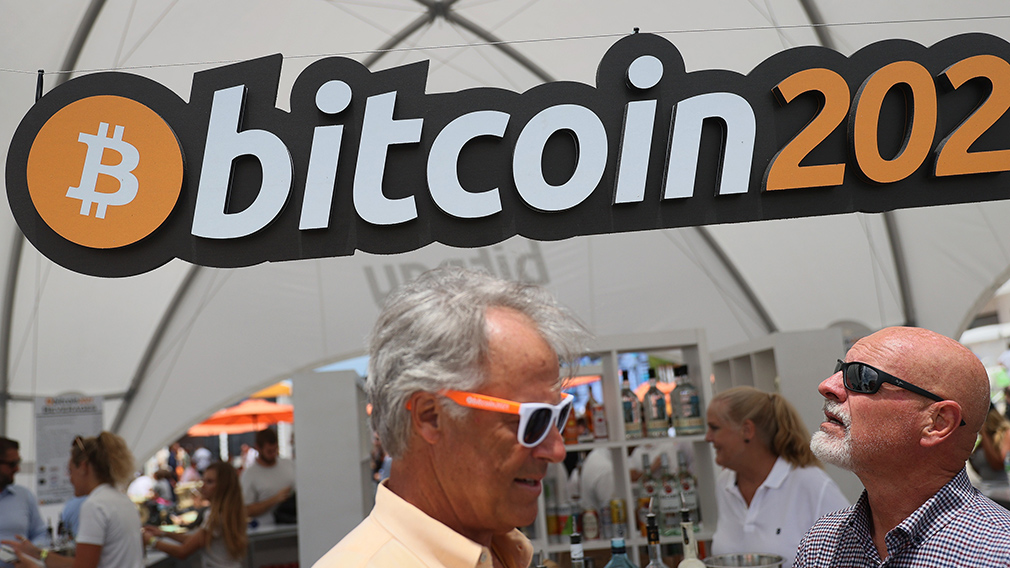Crypto craze: red herring or digital money’s main game?

People at a crypto-currency conference last month in Miami, Florida that was expected to draw 50,000 people. (Getty)
When Glauber Contessoto appeared on The New York Times’ popular podcast The Daily in May, the “conversation with a Dogecoin millionaire” did little to shift the perception of a stereotypical cryptocurrency investor.
“I look at Dogecoin as the future. I truly believe in the cryptocurrency,” the 33-year old told the podcast, which reportedly averages around four million downloads a day.
He had good reason to believe.
After an initial $US40 punt on Dogecoin for some “fun”, he invested his life savings and turned a $US250,000 exposure into a holding at one point worth almost $US2.5 million. Overnight, he became a hero to the army of crypto and meme stock faithfuls fuelling one of the most divisive new markets in decades.
“My generation just woke up on this. We realise the system is rigged…(but) cryptocurrency is a new space, it’s the future,” Contessoto said.
“There aren’t any hedge funds trying to keep us down, there isn’t any billionaires on the other side that if we win, they lose, so the same way we all pooled around GameStop, we can pool around Dogecoin and actually change the future of currency.
“Dogecoin is the bridge… between the real world and the cryptocurrency world.”
However, new research from one of the most renowned finance institutions disputes the “hypothesis” that the crypto craze is being driven by demand for “alternatives to the mainstream financial system” and distrust of incumbents.
Using Federal Reserve Bank of Atlanta survey data from 2014 to 2019, the Bank for International Settlements found cryptos “are not sought as an alternative to fiat currencies or regulated finance, but instead are a niche digital speculation object”.
In other words, punters eyeing a quick buck.
“Compared with the general population, investors show no differences in their level of security concerns with either cash or commercial banking services,” the BIS working paper released last week says.
As regulators and governments increasingly dig into the implications of the rise of cryptos and other digital currencies and tokens, the BIS’s analysis shines a fresh light on who the buyers are and why they’re piling in.
It found US crytpo investors were generally male, young, digitally savvy and educated. In addition, owners are increasingly holding, or “hodling” as the crypto lingo goes, for “longer periods”, challenging the idea the space is dominated by short-term traders betting prices will rise.
“Our results – which show that cryptocurrency investors tend to be educated – to some extent imply that a majority of cryptocurrency investors are aware of the inherent risks,” the report's authors say, adding that because investors tended to be better educated, they may be less susceptible to crypto scams and fraud.
The fervour towards the space is not just a US story.
.png)
Almost 20 per cent of Australians – or 3.3 million people – own a form of crypto, up from 12 per cent in January, according to Finder. In June, the comparison site however noted just one of 40 economists that took part in one of its surveys had bought crypto, some decrying its use in criminal activities. Around three quarters of those surveyed expected other countries to eventually follow China’s recent crackdown on cryptos that rocked the market.
“While crypto enthusiasts will call it digital gold and regard it as an asset, several experts on the panel likened it to gambling,” Finder’s head of consumer research Graham Cooke said, adding that women had also showing greater interest in the past year during COVID-19.
Since the space took off in the past five years, cryptos have regularly been dubbed a “bubble”, “dangerous”, “mania”, “worthless” and “crazy” by some of the finance world’s most revered leaders. Others criticise their limited practical use as a medium of exchange and the astronomical amount of energy required to “mine”, or create, some via powerful computing.
Still, the biggest out of the thousands of cryptos out there, Bitcoin, has a market capitalisation of more than $US600 billion and enthusiasm is showing no sign of dying down, even in the face of extreme volatility and recent price declines. Institutional investors have even been wading in – a survey of 1500 major investment firms from around the world by JPMorgan last month found 10 per cent trade in cryptos.
Reflecting the division and emotion cryptos conjure, JPMorgan noted: “51 per cent feel it is here to stay or even become an important asset and 49 per cent say it is ‘rat poison’ or a temporary fad.”
Bitcoin is thought to have emerged in a white paper by its pseudonymous creator Satoshi Nakamoto in October 2008 as the global financial crisis rocked economies.
Although the timing coincided with a backlash against banks, a major Citigroup report on the future of money in April claimed Bitcoin was the “synthesis of decades of previous experiments and innovations” by cryptographers trying to create decentralised digital money exchangeable on a peer-to-peer basis outside of governments and banks.
More than a decade on, Bitcoin’s birth appears to have been a key development in the digitisation of money that now includes the emergence of "central bank digital currencies" and "stablecoins", alongside ongoing developments in the mainstream account-based “fiat” format most people transcat with online every day.
And despite Bitcoin’s growth and the potential of the blockchain distributed ledger technology underpinning its use, Citi’s analysts note digital currencies in general are still about where the Internet was in 1992.
As such, valuing cryptos is no easy feat, not helped by their differing characteristics.
“Bitcoin is more of a digital commodity whereas certain crypto tokens, such as those issued for raising venture capital, can have equity-like characteristics,” Citi wrote. “In our view, utility is the key to valuation. Because Bitcoin means different things to different people, establishing a valuation is difficult.”
Despite these difficulties, Bitcoin this year hit a record high of almost $US65,000 in April after some high-profile endorsement, namely a $US1.5bn investment by Tesla, whose founder Elon Musk has become a regular crypto tweeter. But the price has corrected hard since China’s clamp down and Musk’s backtracking on Tesla’s plans to accept Bitcoin, taking Dogecoin and other cryptos down with it.
For the BIS, given it appears people are buying cryptos for the same reasons they do other assets – financial gains – it’s time to more clearly clarify the rules of the game.
.png)
“From a policy perspective, the overall takeaway of our analysis is that as the objectives of investors are the same as those for other asset classes, so should be the regulation,” the researchers say, noting that a “clarifying regulatory and supervisory framework” for crypto markets could benefit the industry.
They added that it would be important to apply “technology-neutral” regulation, while also harnessing the tech's benefits through “embedded supervision” – allowing compliance to be automatically monitored via distributed ledgers.
“The main aim is low-cost supervision of decentralised markets, which may be particularly relevant amidst recent deliberations of the need for adequate prudential oversight of the cryptocurrency industry,” they say.
Early last month, the Basel Committee on Banking Supervision – the global standard setter for the industry – kicked off consultation on proposals for the treatment of crypto asset exposures, a process the Australian Prudential Regulation Authority has contributed to and supports. While exposures to crypto are currently limited, the Basel Committee said the “continued growth and innovation in crypto assets and related services, coupled with the heightened interest of some banks, could increase global financial stability concerns and risks to the banking system in the absence of a specified prudential treatment”.
Separately, several central banks – including the Reserve Bank of Australia – are ramping up their investigations into central bank digital currencies, or CBDCs, which have emerged alongside cryptos.
Such is the momentum, barely a week goes by without a central banker somewhere talking about CBDCs, with China thought to be the closest to actual use. Citi describes CBDCs as being different to other forms of electronic central bank money such as reserves because they can be “exchanged in a decentralised manner” using distributed ledger technology, rather than in a centralised fashion across participants’ accounts.
Further crowding (or complicating?) the space, the private sector is also wading in, most notably Facebook through its Diem (formerly Libra) stablecoin – digital currencies in which the value is tied to “fiat” currencies like the US dollar. CBDCs are also linked to government-backed currencies, whereas the values of cryptos are driven by supply and demand.
“Money is entering a format war, but unlike similar conflicts in video or electricity, we do not see this as a winner-take-all competition,” the Citigroup report says.
“We believe tokenised and account-based money, centralised and decentralised money, will all co-exist. However, tokenised money, such as CBDCs, stablecoins and cryptocurrencies such as Bitcoin are relatively new and could be disruptive to the existing monetary, banking, and payment structures.”
Making headlines last month, the BIS firmly backed CBDCs and criticised cryptos, saying the former can “open a new chapter for money grounded on trust in the central bank” and “further the public interest”.
It backed banks and payments providers being involved in CBDCs alongside central banks through “two-tier systems” to bring their “innovative capacity to serve customers”. The BIS advocated for CBDCs to be designed in a way that is tied to digital identity to balance the risks around abuse of personal data, and money laundering and financial crime. International cooperation on design would be “vital”, with industry experts believing it’s more likely following the accelerated digitisation of economies during the COVID-19 pandemic.
“Innovations such as cryptocurrencies, stablecoins and the walled garden ecosystems of big techs all tend to work against the public good element that underpins the payment system,” the BIS said. “CBDCs represent a unique opportunity to design a technologically advanced representation of central bank money, one that offers the unique features of finality, liquidity and integrity.
“Such currencies could form the backbone of a highly efficient new digital payment system by enabling broad access and providing strong data governance and privacy standards based on digital ID.”
To date, the RBA has been lukewarm on the prospect of CBDCs, late last year reiterating that the “public policy case” for issuing a general purpose, or retail CBDC, was “still to be made”. The Bank, however, is continuing its research, including a project on the potential use of a wholesale CBDC using distributed ledgers.
“Even though the use of cash for transactions is declining, cash is still widely available and accepted as a means of payment,” the RBA’s head of payments policy Tony Richards told a crypto and fintech conference in October.
“In addition, Australian households and businesses are well served by a modern, efficient and resilient payments system that has undergone significant innovation in recent years, including the introduction of the New Payments Platform, which is a real-time, 24/7 and data-rich electronic payments system.”
Australian lawmakers, however, are stepping up their interest in what the future of cryptos and digital money more broadly should look like, noting opportunities and risks.
In a recent issues paper, the Senate inquiry into “Australia as a Technology and Financial Centre” – which is due to release its final report by October 30 – called out the potential economic opportunities from blockchain technology across several industries, and how important it was to get the settings right to provide certainty and attract investment.
“In particular, the committee will be assessing options for the development of a comprehensive regulatory framework for cryptocurrency and digital assets,” the Committee said, adding the approaches of Canada, Singapore, the United Kingdom and Europe would be closely evaluated.
It may still be early days for digital currencies.
But it appears to be fast morphing from a crypto craze into good old cash, in one way or another.
The views expressed are those of the author, and do not necessarily reflect those of the Westpac Group.
The information in this article is general information only, it does not constitute any recommendation or advice; it has been prepared without taking into account your personal objectives, financial situation or needs and you should consider its appropriateness with regard to these factors before acting on it. Any taxation position described is a general statement and should only be used as a guide. It does not constitute tax advice and is based on current tax laws and our interpretation. Your individual situation may differ and you should seek independent professional tax advice. You should also consider obtaining personalised advice from a professional financial adviser before making any financial decisions in relation to the matters discussed.




